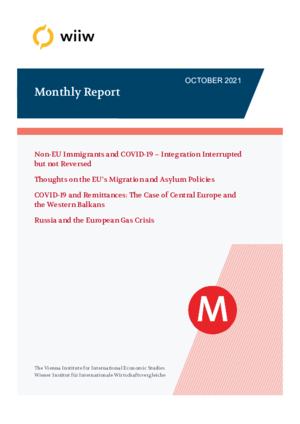Monthly Report No. 10/2021
Andrei V. Belyi, Michael Landesmann, Sebastian Leitner and Isilda Mara
wiiw Monthly Report No. 10, October 2021
51 pages including 2 Tables and 32 Figures
- Chart of the Month: Non-EU immigrants and COVID-19 – Integration interrupted but not reversed
by Sebastian Leitner
- Opinion Corner: Thoughts on the EU’s migration and asylum policies
by Michael Landesmann
EU policy is developing increasingly in the direction of ‘Fortress Europe’, with the emphasis on external border management plus attempts to cooperate with the countries of origin and transit countries in stemming migrant and refugee flows. Instead, migration policy should be embedded in a more holistic approach that supports and nurtures the development potential of the EU’s neighbouring regions. It should also recognise that the demographic complementarity between an ‘ageing Europe’ and a population-rich and ‘young South’ could be exploited to mutual benefit.
- COVID-19 and remittances: the case of Central Europe and the Western Balkans
by Isilda Mara
The dynamics of remittances in the wake of the COVID-19 pandemic have been highly uneven across countries. In Central Europe, where incomes are relatively high and there are many cross-border commuters, the inflow of remittances generally declined last year. In contrast, in some Western Balkan countries, where dependence on remittances was much higher to start with and a large share of emigrants are permanently settled in some of the wealthiest European countries, remittances surged, providing a lifeline to many households affected by the pandemic.
- Russia and the European gas crisis
by Andrei Belyi
The current European gas crisis has resulted from the market cycles which are inherent to commodities. In recent years, LNG inflows have allowed the development of a competitive market, but reduced supplies in the wake of the pandemic have conditioned a sharp hike in gas prices. Although Gazprom has not been directly behind the crisis, it has taken advantage of it mostly by reducing gas flows via Ukraine. Meanwhile, Gazprom continues to fulfil its commitments under long-term oil-indexed contracts, which have existed in parallel with the competitive gas hubs. Hence, recent EU appeals to Russia to increase gas supplies are seen in Moscow as a step towards a partial return to long-term oil-indexed contracts and an opportunity to strengthen Russia’s geopolitical standing in Europe.
- Monthly and quarterly statistics for Central, East and Southeast Europe
Reference to wiiw databases: wiiw Annual Database, wiiw Monthly Database, wiiw FDI Database
Keywords: non-EU migrants, employment rate, COVID-19, migration and asylum policies, demographic complementarity, remittances, liquified natural gas, long-term gas contracts, natural gas pricing
Countries covered: CESEE, EU, EU-CEE, Russia, Western Balkans
Research Areas: Labour, Migration and Income Distribution, Sectoral studies
